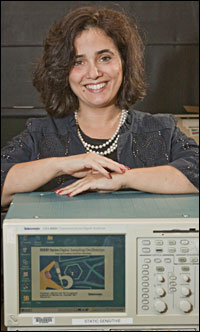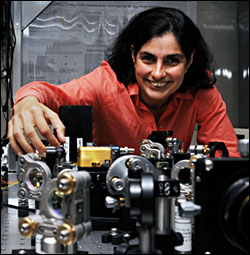
Physicists Win MacArthur Grants
ITHACA, N.Y., & CAMBRIDGE, Mass., Sept. 28, 2010 — An optical physicist at Cornell University working to develop silicon-based devices that harness the information-processing capabilities of light and an MIT physicist whose research links the worlds of quantum mechanics and astronomy were named today as recipients of five-year, $500,000 no-strings-attached 2010 MacArthur Foundation fellowships.
Cornell University optical physicist Michal Lipson "has emerged as a leader, despite relatively modest resources, in designing optical and hybrid opto-electronic devices with silicon-based fabrication methods," the John D. and Catherine T. MacArthur Foundation said in a statement announcing her award.

Cornell University optical physicist Michal Lipson. (Courtesy the John D. & Catherine T. MacArthur Foundation)
Lipson is working to find alternatives to conventional silicon computer chips, a mature technology that uses electronic circuits and cannot match the theoretical speed and capacity of optical systems.
Lipson has demonstrated that ring modulators (circular waveguides) can effectively serve as switches for light passing through adjacent linear waveguides when the frequency of light pumped into the modulators is precisely tuned relative to the linear waveguide. Her continued refinement of both opto-electronic and purely optical circuits has decreased their size, increased their efficiency, and accelerated their switching speed. The resulting silicon-based photonic integrated circuits have the potential to improve signal transmission and processing dramatically.
"Lipson's elegant solutions to a variety of theoretical and engineering challenges in silicon photonics are paving the way for the future development of practical and powerful optical computing devices," the foundation said.
MIT physics professor and quantum astrophysicist Nergis Mavalvala's research aims to detect gravitational waves — ripples in the fabric of space and time that were predicted by Albert Einstein. Gravitational waves carry information on the motions of objects in the universe, and scientists believe that by detecting gravitational waves they will be able to observe further back into the history of the universe than ever before.
As a graduate student, Mavalvala developed a prototype laser interferometer for detecting gravitational waves. This early work led to the identification of an important stabilization principle that was later incorporated into the design for the Laser Interferometer Gravitational-Wave Observatory (LIGO), a collaboration among scores of physicists and currently the most sensitive observatory of its kind.
Mavalvala's more recent research focuses on minimizing, if not circumventing, barriers imposed by quantum physics on the precision of standard optical interferometers. One strategy she uses is to cool the macroscopic components of the device (i.e., the mirrors) into a coherent quantum state; such components, large enough to see without magnification, exhibit bizarre quantum properties previously observed only at the atomic level.

Nergis Mavalvala works in the lab at MIT. (Courtesy the John D. & Catherine T. MacArthur Foundation)
Applying strategies such as this at the scale of the LIGO instruments (i.e., kilogram-scale mirrors separated by kilometers) has the potential to boost significantly the sensitivity of the device. Through this and other technically challenging, unconventional approaches, such as squeezed coherent states and optical springs, Mavalvala is making fundamental contributions to physics at the intersection of optics, condensed matter, and quantum mechanics, the foundation said.
"Her experimental advances are enhancing our ability to detect and quantify gravitational radiation with still greater precision, data that may be critical to incorporating gravitation within a unified theory of the basic forces in the universe," the foundation said.
Since 1981, MacArthur Fellowships, also known as “genius” grants, have come without stipulations or reporting requirements – an unusual level of independence for a grant — and offer fellows unprecedented freedom and opportunity to reflect, create and explore. Nominations are accepted only from invited nominators who are chosen from many fields and challenged to identify people who demonstrate exceptional creativity and promise. The number of fellows selected each year is not fixed, and usually varies between 20 and 25. Because there is no application process for the award, the phone call that they have won often comes "out of the blue" to recipients.
The 2010 MacArthur Fellows also include high school physics teacher Amir Abo-Shaeer, director of Dos Pueblos Engineering Academy in Goleta, Calif.
Including this year's group of 23, 828 people, ranging in age from 18 to 82 at the time of their selection, have been named MacArthur Fellows since the inception of the program 30 years ago.
For more information, visit: www.macfound.org, www.cornell.edu or www.mit.edu
Published: September 2010